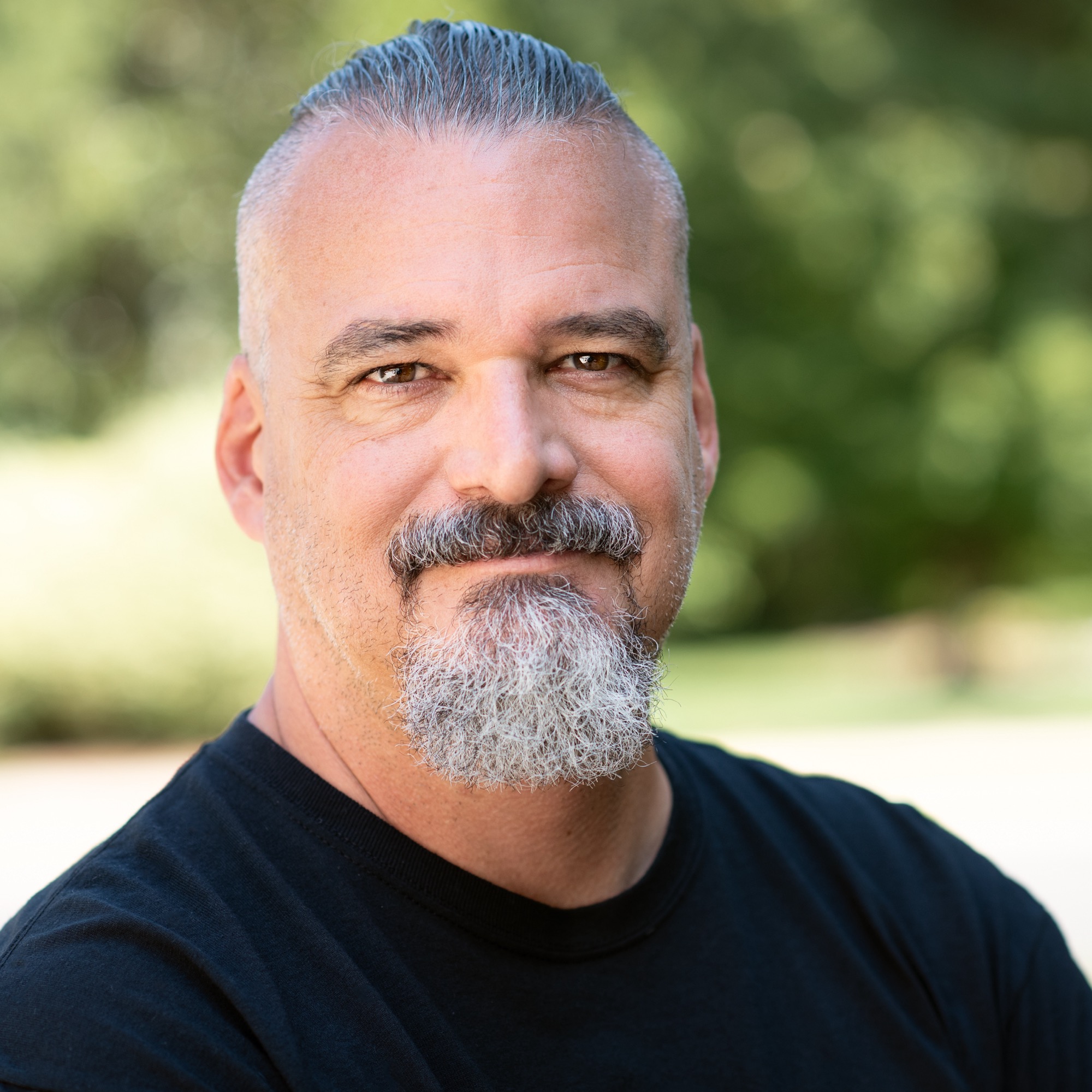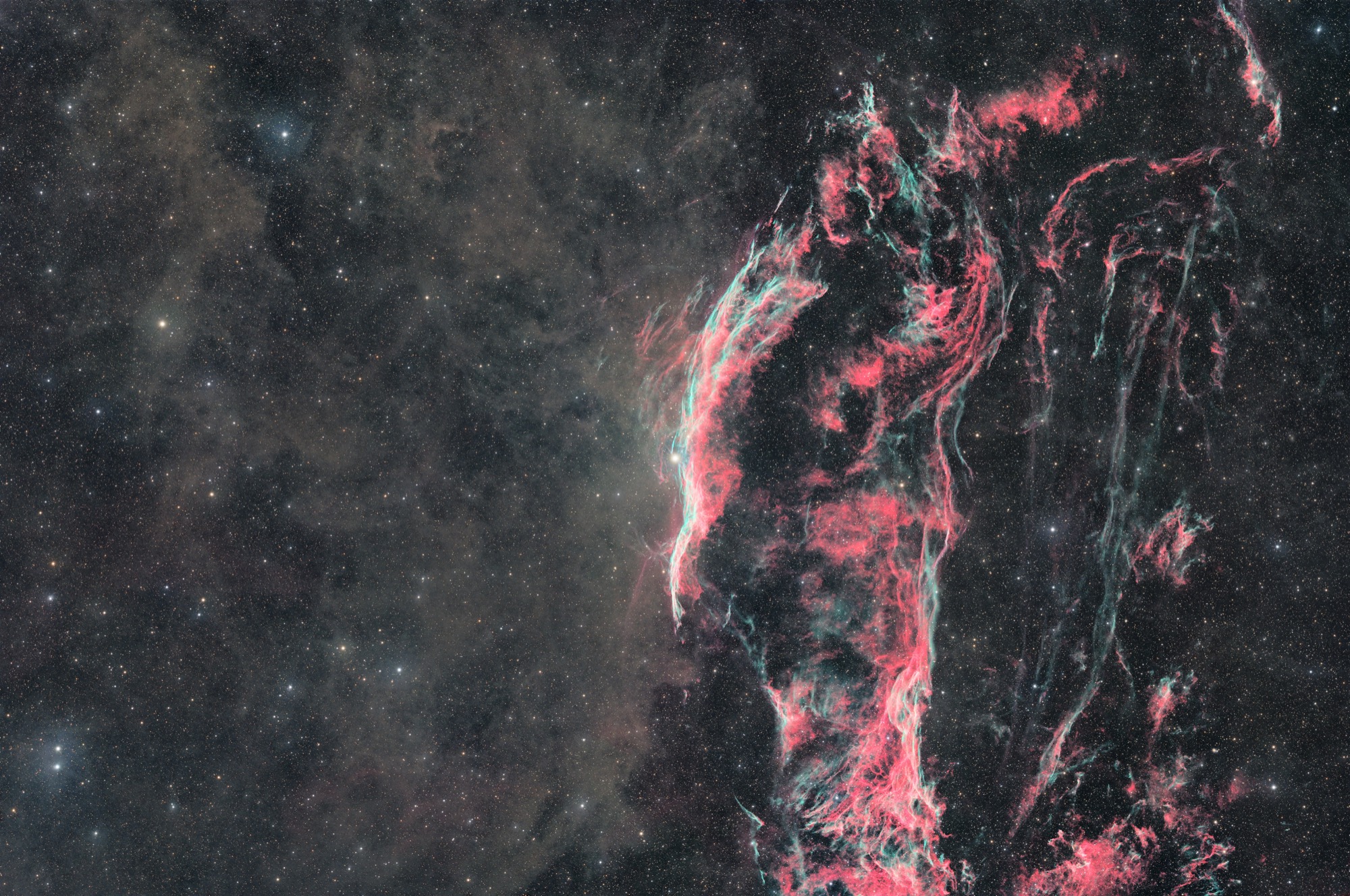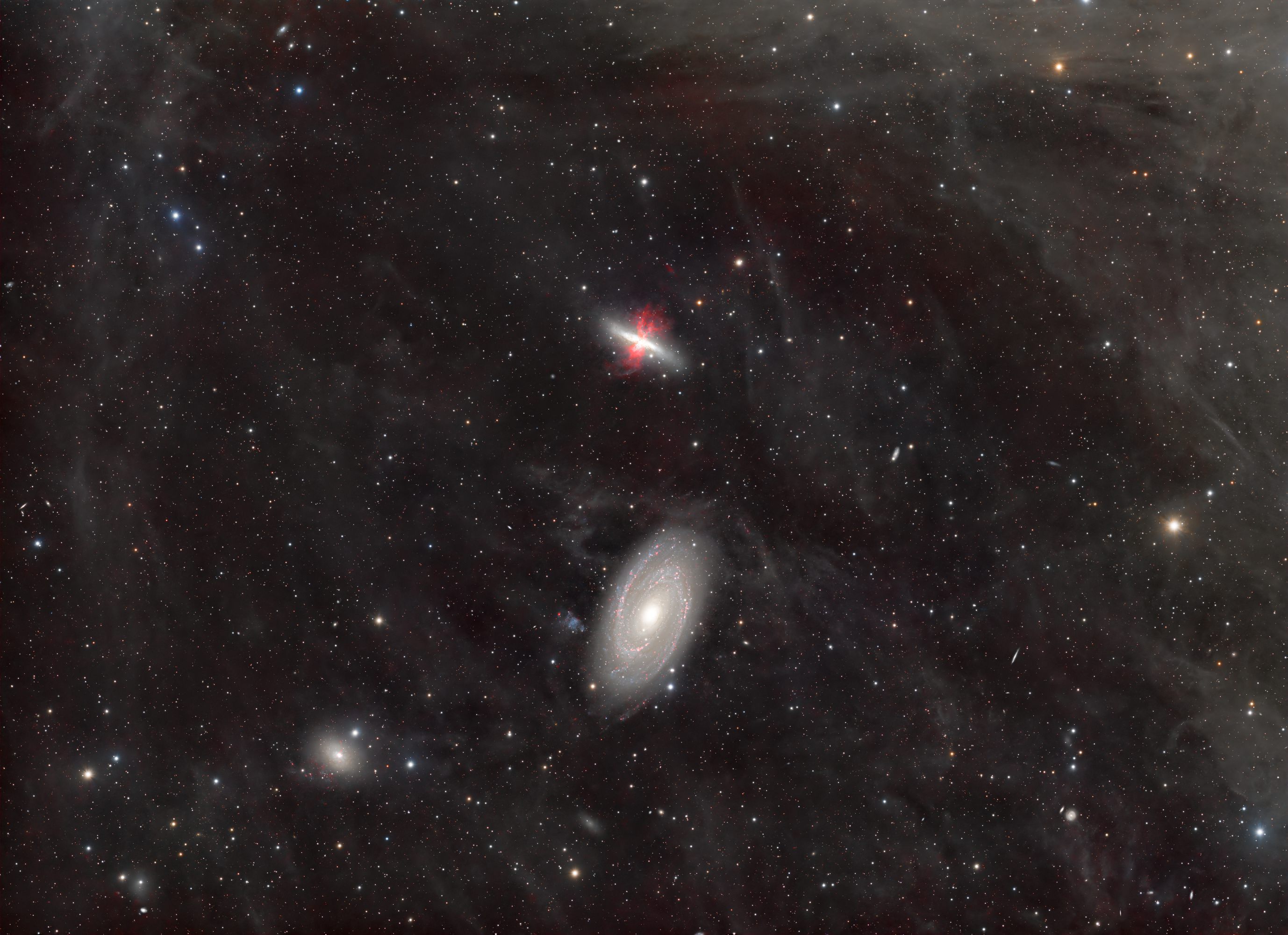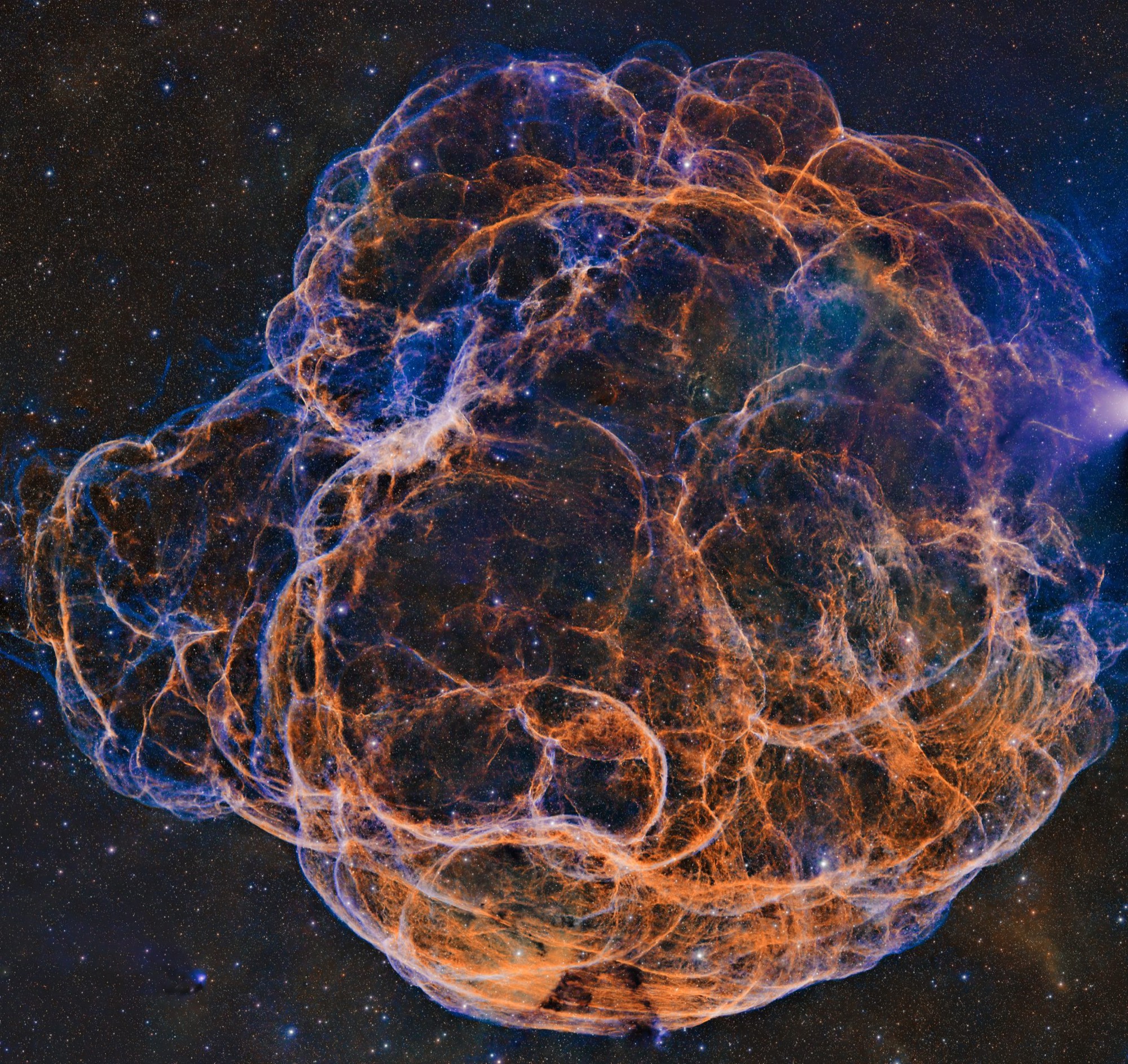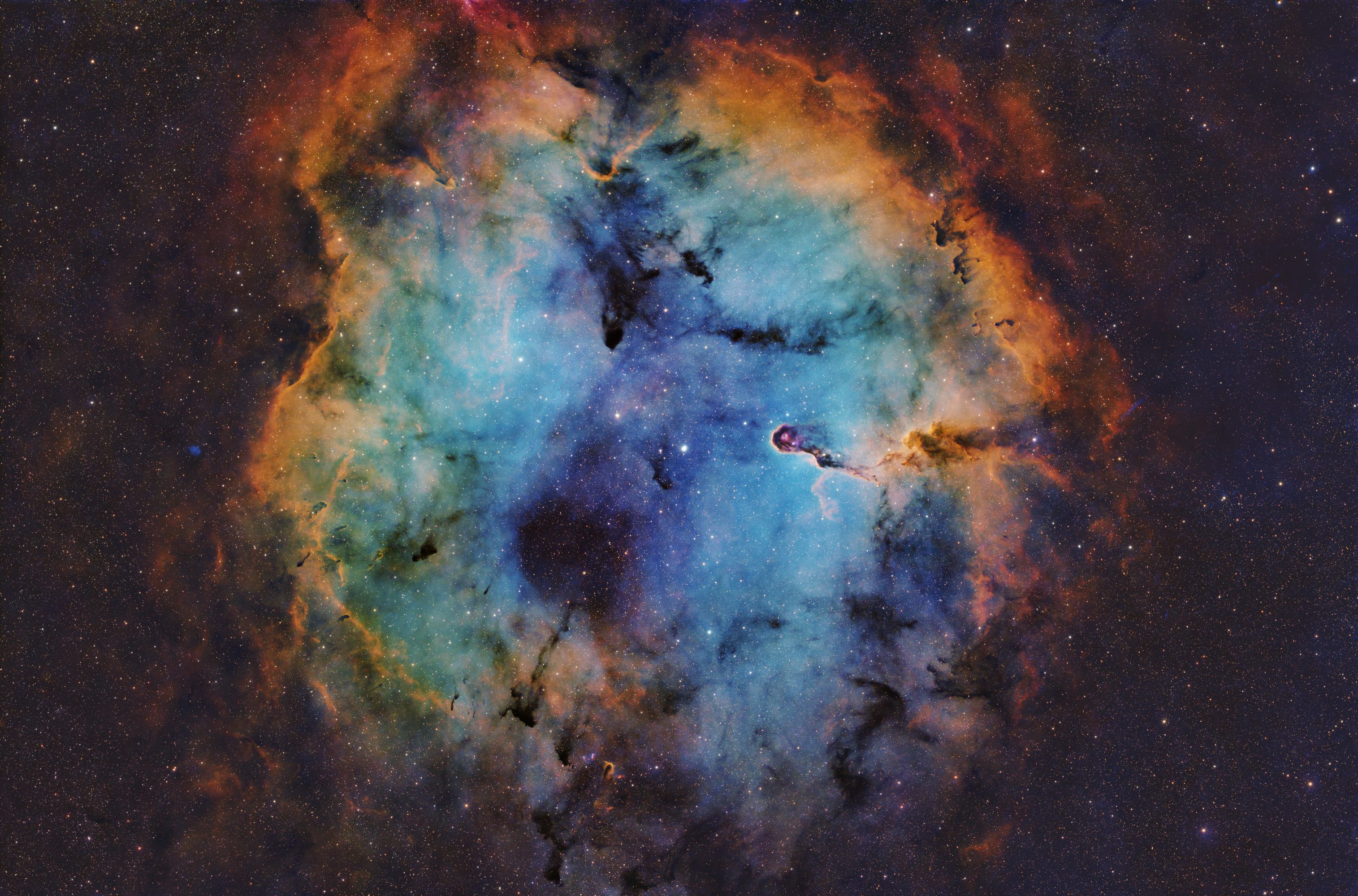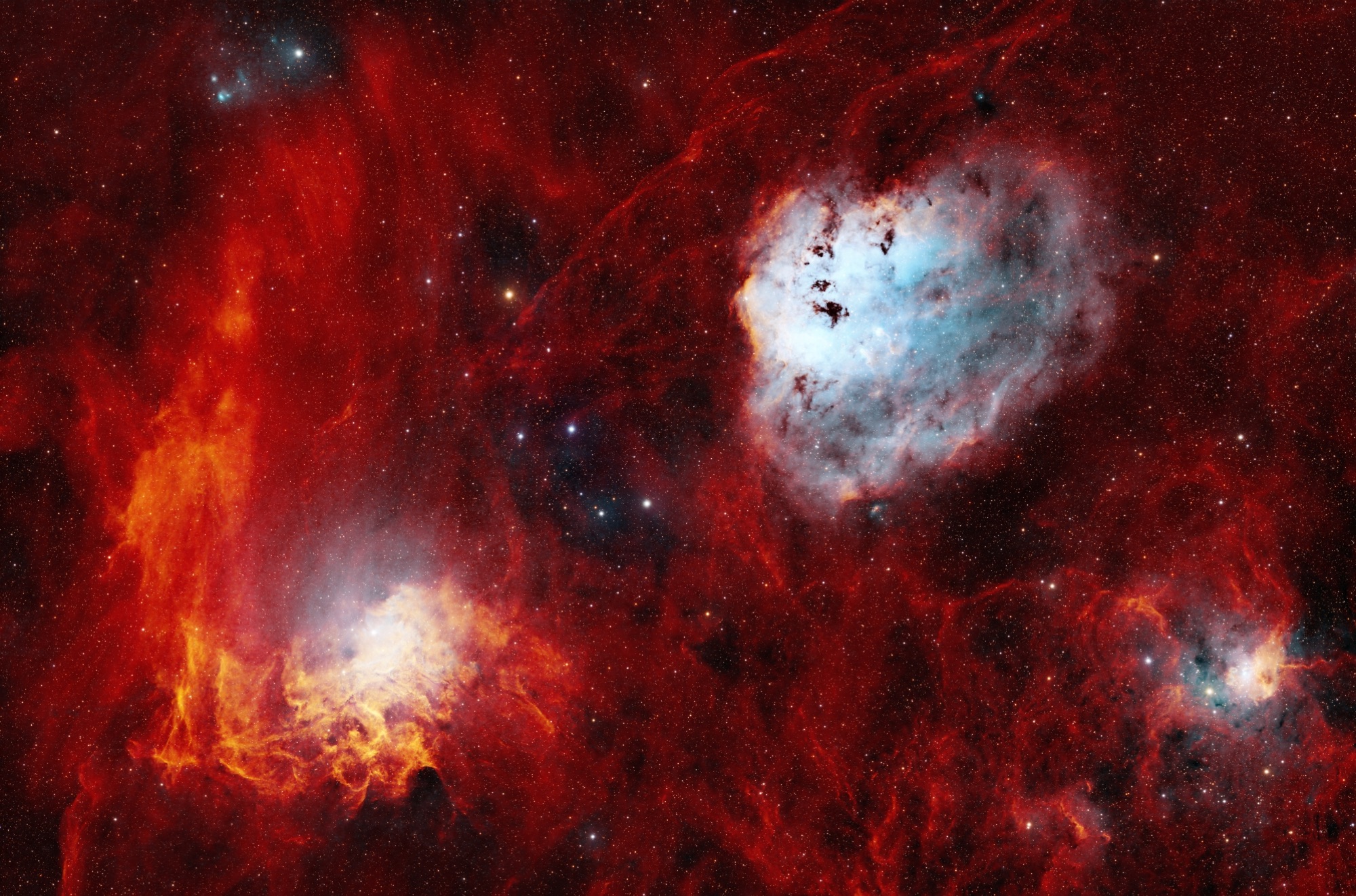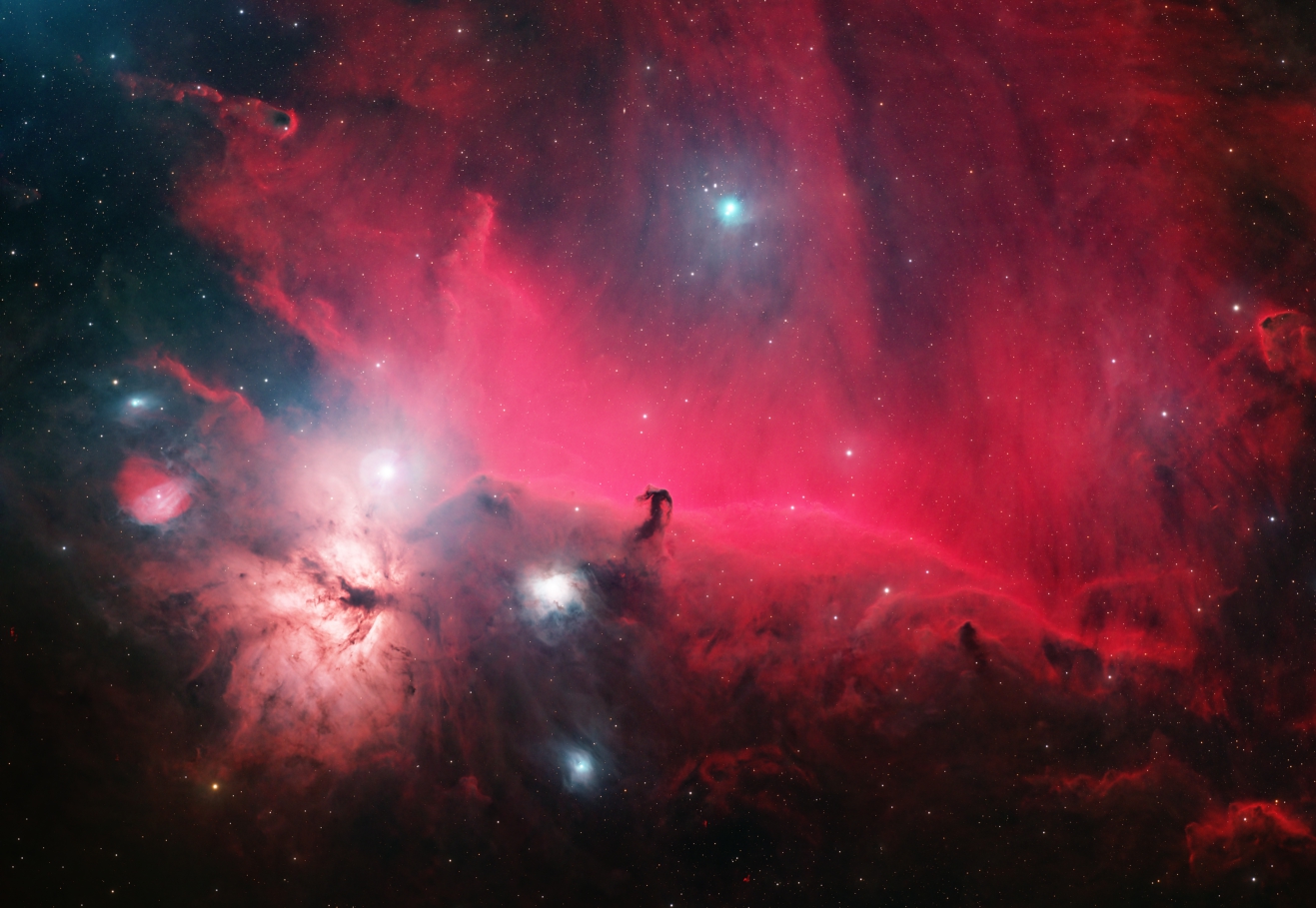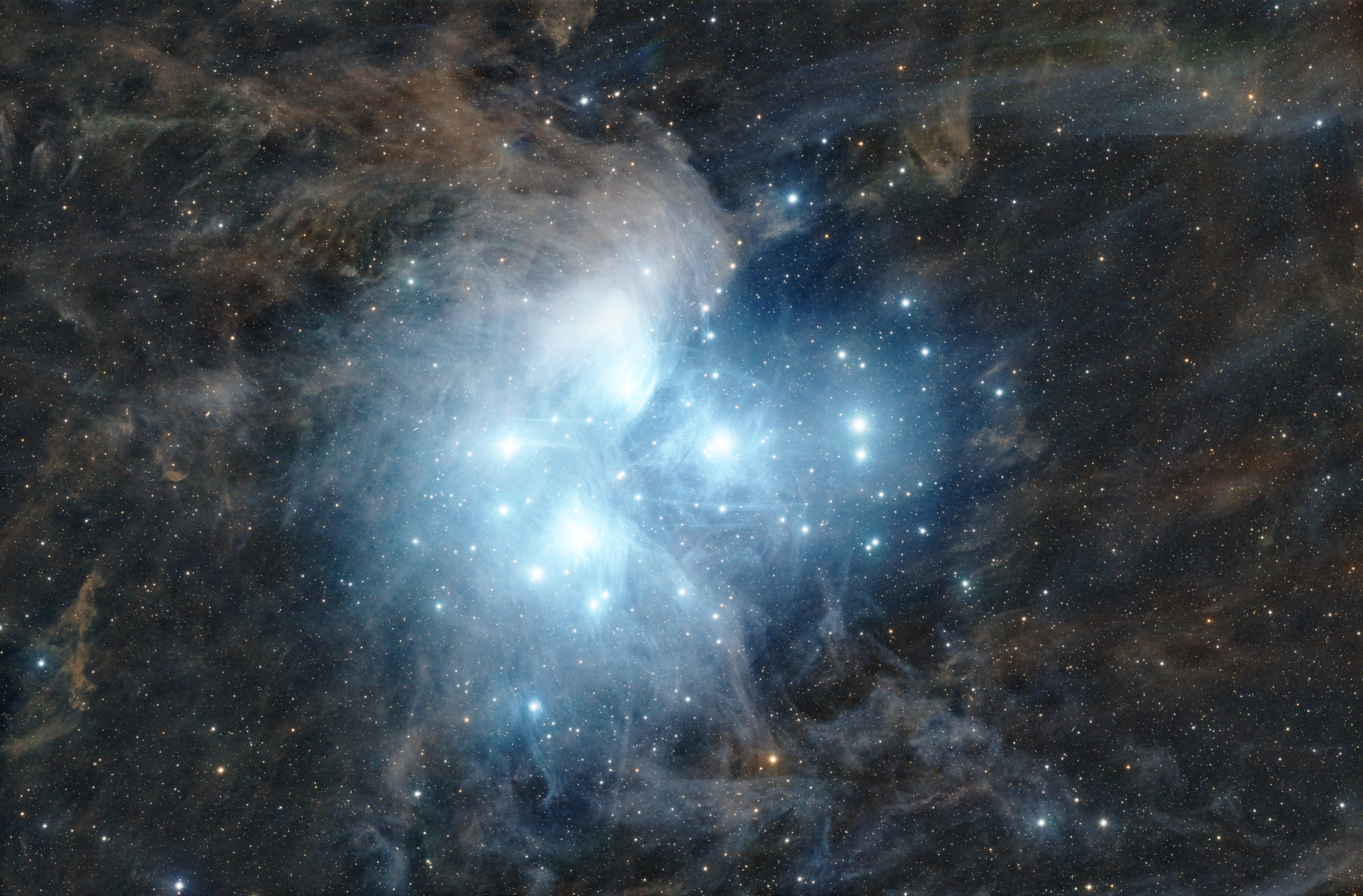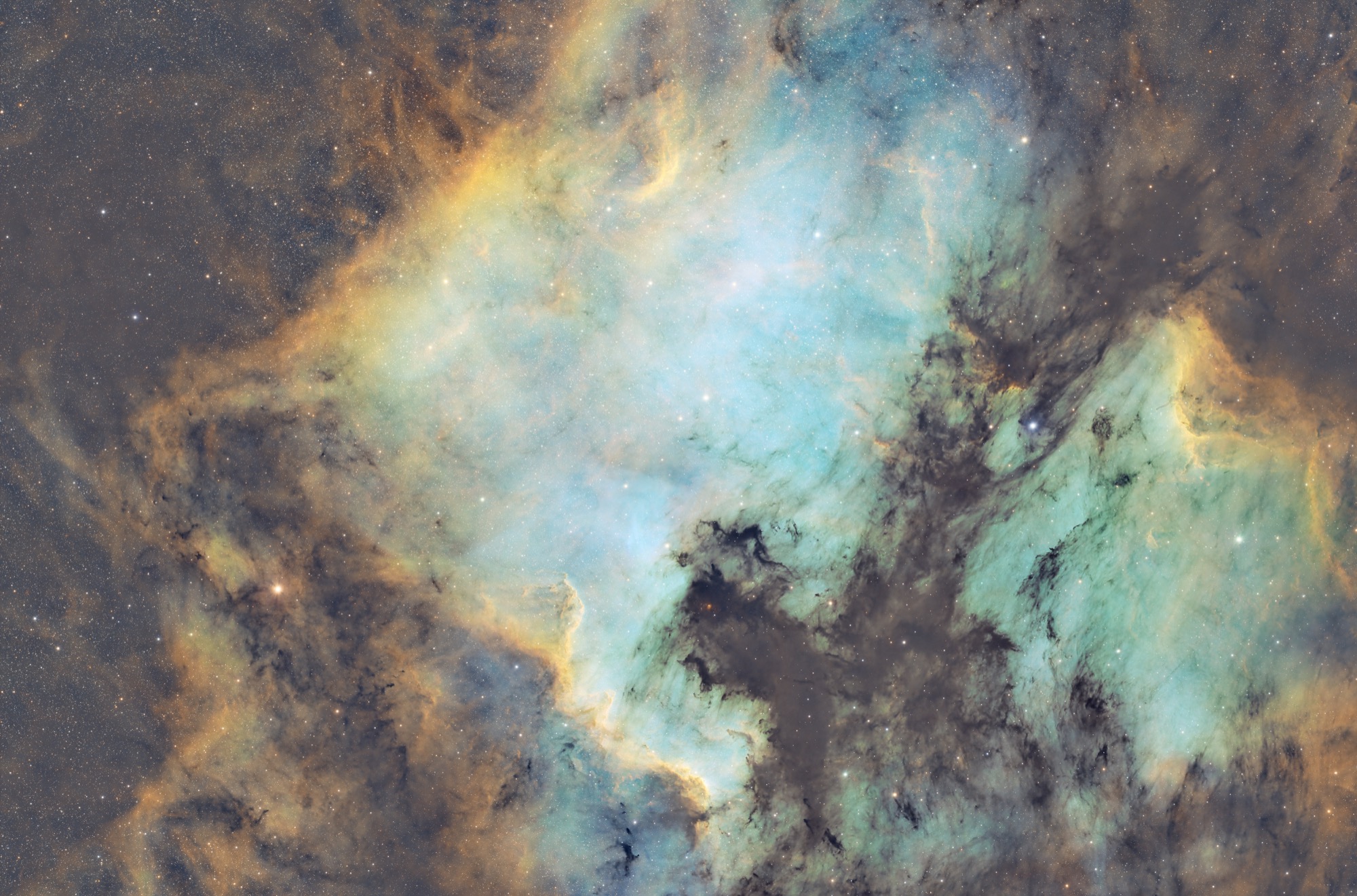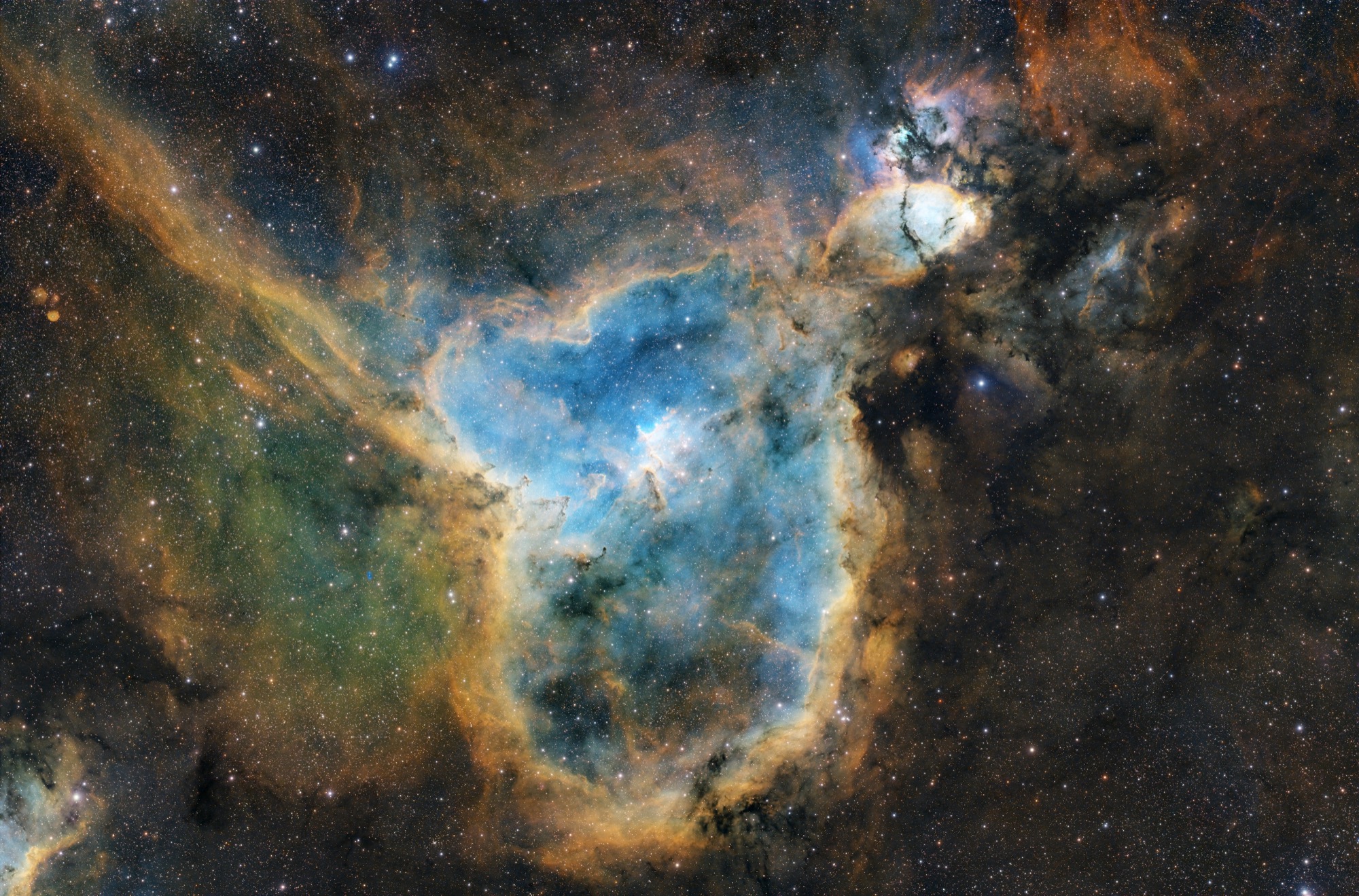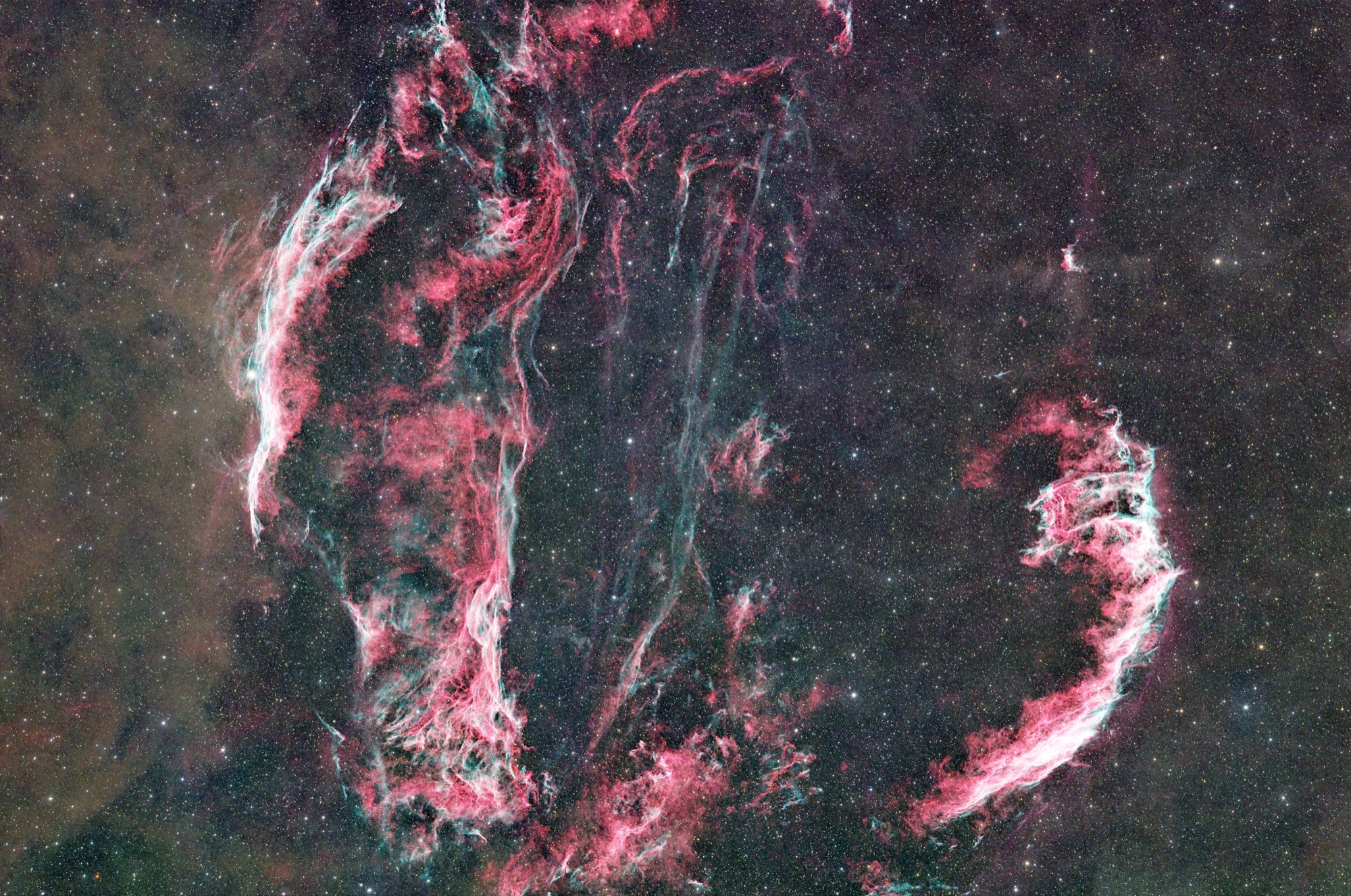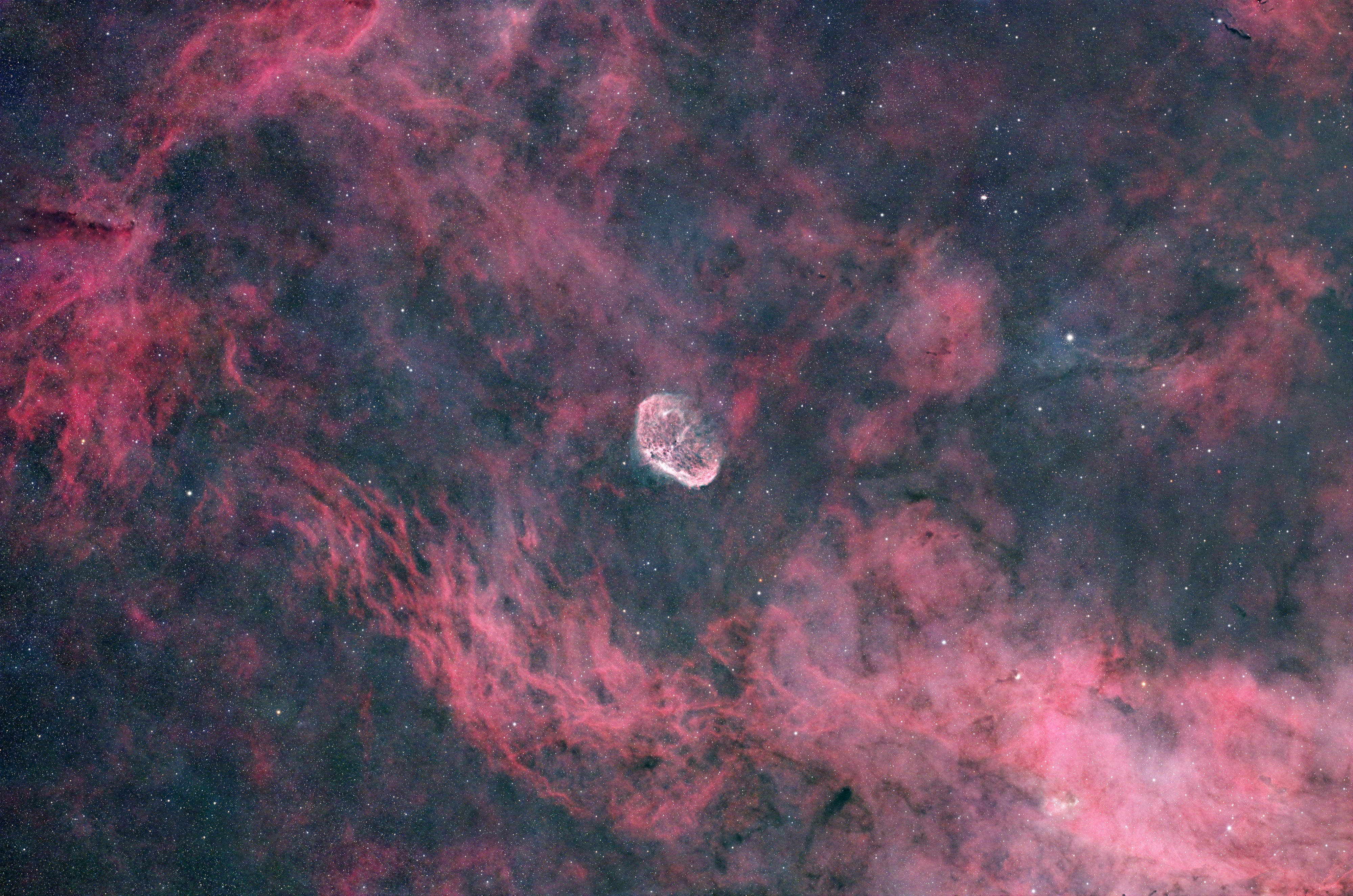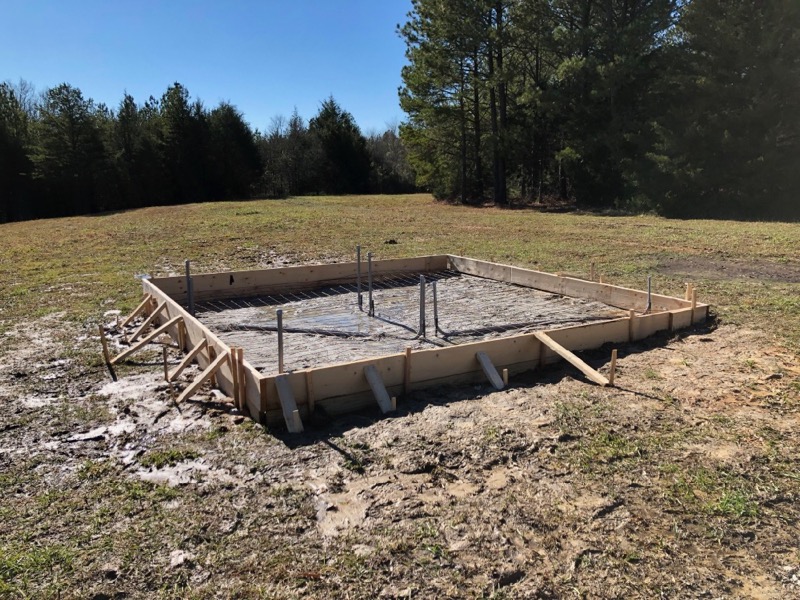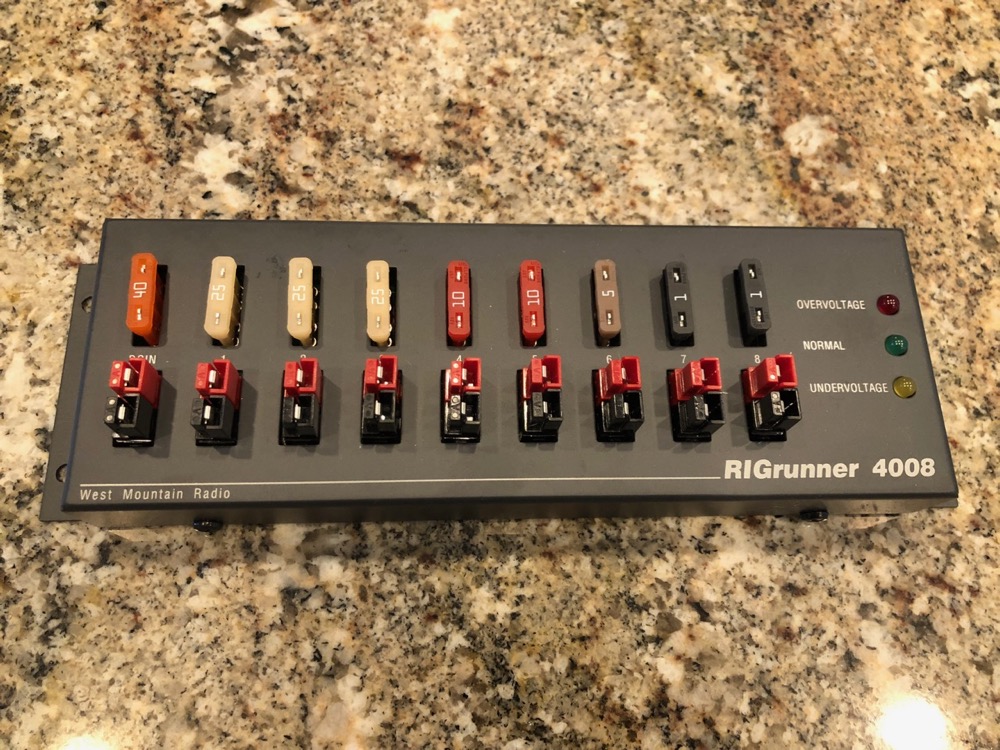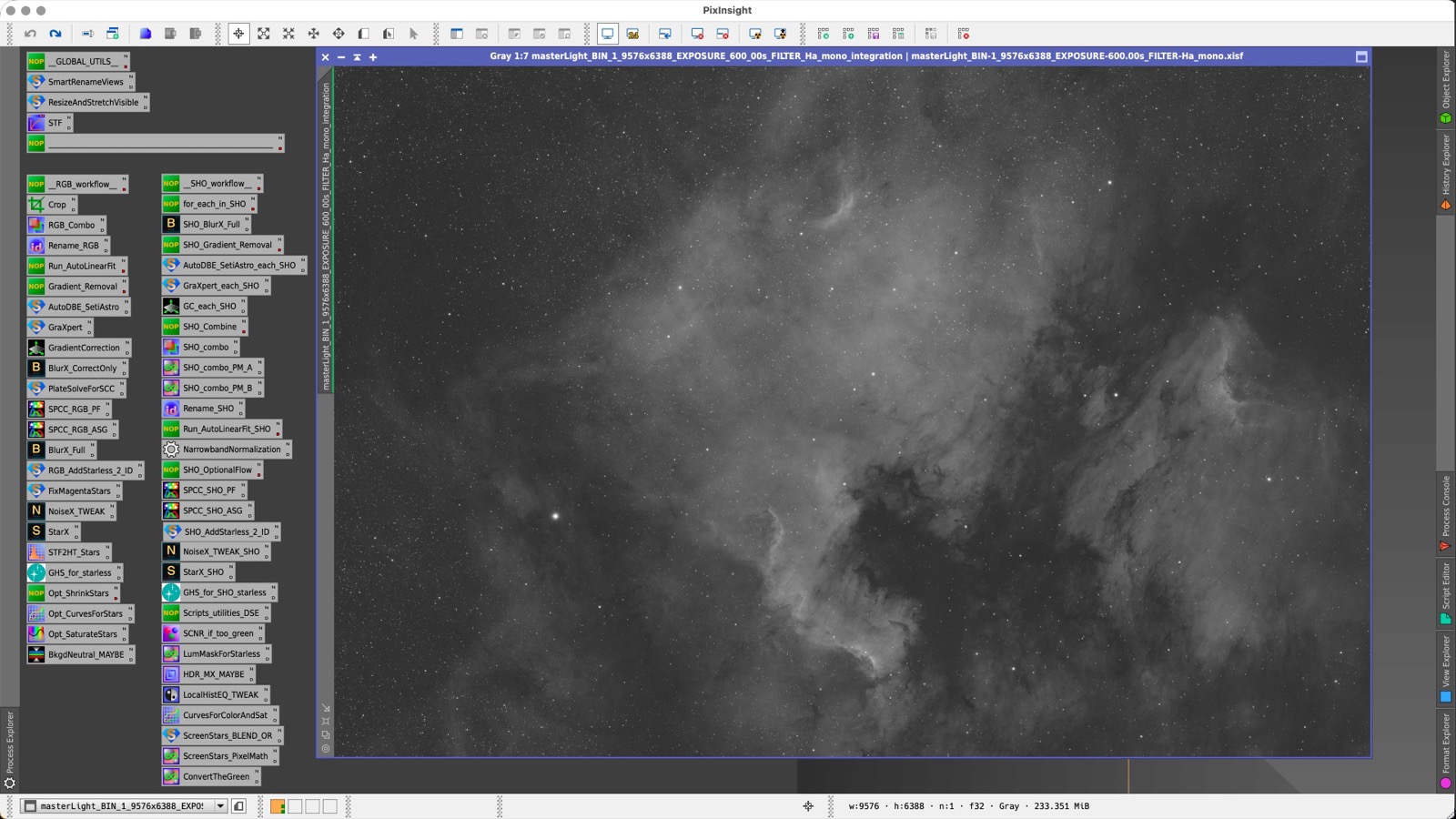This was a reprocess and reframing of the Witch’s Broom in the Western Veil Nebula.
Read more...
Posts by Tag
- ghro 18
- NINA 14
- nebula 12
- TargetScheduler 10
- galaxy 5
- unboxing 5
- atik 5
- gear 4
- messier 4
- RGB 4
- astroshed 3
- automation 3
- beginner 2
- zwo 2
- software bisque 2
- scripting 2
- narrowband 2
- PixInsight 2
- SHO 2
- sketches 2
- widefield 1
- Milky Way 1
- takahashi 1
- theskyx 1
- organization 1
- primalucelabs 1
- eagle 1
- Heart Nebula 1
- supernova 1
- snr 1
- mosaic 1
- north 1
ghro
The Witch’s Broom Nebula (reprocess)
Quickshot: the Western Veil Nebula (NGC6960)
I haven’t been able to image lately for a number of reasons, some just personal crap,
but also because the weather here the past few months has just sucked.
Read more...
M81 and M82 in RGB blended with narrowband subtracted continuum
This is a quick post on the M81/M82 region, also known as Bode’s and Cigar Galaxies, respectively.
Read more...
Spaghetti Nebula, two-panel SHO mosaic with RGB stars
This is a two-panel mosaic of Siemeis 147, AKA Sharpless 2-240, affectionately
known as the “Spaghetti Nebula”. The Spaghetti Nebula is a striking
astronomical object located in the constellation of Taurus. This ethereal cloud
of gas and dust appears as a delicate, curved nebula with intricate filaments
that evoke the image of twisted pasta.
Read more...
Quickshot: The Elephant Trunk Nebula (SHO with RGB stars)
I realized that I never processed the Elephant Trunk Nebula that I started taking at the
end of 2024. I had expected to go back and get more data but never did, and now it’s too low.
Read more...
The Flaming Star, Tadpoles, and Spider Nebulae
I gathered about 40 hours of narrowband and broadband data for this rendition of the Flaming Star,
Tadpoles, and Spider Nebulae over a ten-day session in late 2024/early 2025.
Read more...
The Horsehead and Flame Nebulae, in RGB plus Narrowband
This is my late-2024 take on the Horsehead and Flame Nebulae in a fairly wide view from my
530mm f/5 refractor. This view, taken over ten different nights, is cropped but if you
click through you can see a bigger view along with processing details.
Read more...
Pleiades (M45) has some dark secrets
I was able to pull out some darker whispies as well as several
galaxies hidden in the mist while imaging Pleiades, AKA M45 or
“The Seven Sisters” (I count a lot more than seven!).
Read more...
Quickshot: The North America Nebula
A quick process of the North America Nebula. This is about eighteen hours of SHO + RGB data and I like how it turned out ![]() .
See below for acquisition details.
.
See below for acquisition details.
Read more...
First remote imaging: Veil Nebula and M101
Another quick post. I have finally had my first night imaging remotely, and everything actually worked!
Read more...
Quickshot: The Crescent Nebula - NCG 6888
Still working out the kinks in my full automation routine but making progress
Read more...
Quick shot of M51, the Whirlpool Galaxy
In my quest to image remotely I needed a dry run.
Read more...
New name, new posts, new plans
If you’ve been following us you’ve likely noticed that we’ve changed our name
and URL, we’re now simply theAstroShed.com. The
near-term plan is to be able to image remotely. The weather that we’ve been
having lately has been very flaky, often not worth the 45-minute drive
(especially in the summer, when it feels like there’s only a few hours of
darkness)
Out with the old (pier).
Read more...
I have a porch!
One issue that I had early on was getting to the astroshed. Not the drive (well,
the South Carolina roads do leave a bit to be desired). No, it was the little OSB
plywood walkway.
Read more...
Introducing The Astro Shed
With the Astroshed nearly complete I thought that it was time to post some pictures of the progress and what all has gone into this project.
Read more...
Groundbreaking! Building the Astro Shed
This post isn’t about astrophotography, but rather a place to do it from. My yard is pretty much out of the question, trees all around, with only a view of the northern sky. You know what else is north? Uptown Charlotte. I was thrilled when I learned that our local astronomy club had an observatory with much darker skies than I have.
Read more...
First night at GHRO
I am now a member of the Charlotte Amateur Astronomers Club, which has an observatory near Kershaw, South Carolina. The Gayle H. Riggsbee Observatory (GHRO for short) has several member pads, along with a good variety of telescopes for club members.
Read more...
NINA
The Witch’s Broom Nebula (reprocess)
This was a reprocess and reframing of the Witch’s Broom in the Western Veil Nebula.
Read more...
Quickshot: the Western Veil Nebula (NGC6960)
I haven’t been able to image lately for a number of reasons, some just personal crap,
but also because the weather here the past few months has just sucked.
Read more...
M81 and M82 in RGB blended with narrowband subtracted continuum
This is a quick post on the M81/M82 region, also known as Bode’s and Cigar Galaxies, respectively.
Read more...
Spaghetti Nebula, two-panel SHO mosaic with RGB stars
This is a two-panel mosaic of Siemeis 147, AKA Sharpless 2-240, affectionately
known as the “Spaghetti Nebula”. The Spaghetti Nebula is a striking
astronomical object located in the constellation of Taurus. This ethereal cloud
of gas and dust appears as a delicate, curved nebula with intricate filaments
that evoke the image of twisted pasta.
Read more...
Quickshot: The Elephant Trunk Nebula (SHO with RGB stars)
I realized that I never processed the Elephant Trunk Nebula that I started taking at the
end of 2024. I had expected to go back and get more data but never did, and now it’s too low.
Read more...
The Flaming Star, Tadpoles, and Spider Nebulae
I gathered about 40 hours of narrowband and broadband data for this rendition of the Flaming Star,
Tadpoles, and Spider Nebulae over a ten-day session in late 2024/early 2025.
Read more...
The Horsehead and Flame Nebulae, in RGB plus Narrowband
This is my late-2024 take on the Horsehead and Flame Nebulae in a fairly wide view from my
530mm f/5 refractor. This view, taken over ten different nights, is cropped but if you
click through you can see a bigger view along with processing details.
Read more...
Pleiades (M45) has some dark secrets
I was able to pull out some darker whispies as well as several
galaxies hidden in the mist while imaging Pleiades, AKA M45 or
“The Seven Sisters” (I count a lot more than seven!).
Read more...
Quickshot: The North America Nebula
A quick process of the North America Nebula. This is about eighteen hours of SHO + RGB data and I like how it turned out ![]() .
See below for acquisition details.
.
See below for acquisition details.
Read more...
First remote imaging: Veil Nebula and M101
Another quick post. I have finally had my first night imaging remotely, and everything actually worked!
Read more...
Quickshot: The Crescent Nebula - NCG 6888
Still working out the kinks in my full automation routine but making progress
Read more...
Quick shot of M51, the Whirlpool Galaxy
In my quest to image remotely I needed a dry run.
Read more...
How I keep my astro images organized
Astrophotography is a pretty data-heavy hobby. One night of imaging can result in
dozens, hundreds, or even thousands of images. In this post I’ll go over my plans
to keep them organized, especially now that I’m starting to image remotely.
Read more...
nebula
The Witch’s Broom Nebula (reprocess)
This was a reprocess and reframing of the Witch’s Broom in the Western Veil Nebula.
Read more...
Quickshot: the Western Veil Nebula (NGC6960)
I haven’t been able to image lately for a number of reasons, some just personal crap,
but also because the weather here the past few months has just sucked.
Read more...
Spaghetti Nebula, two-panel SHO mosaic with RGB stars
This is a two-panel mosaic of Siemeis 147, AKA Sharpless 2-240, affectionately
known as the “Spaghetti Nebula”. The Spaghetti Nebula is a striking
astronomical object located in the constellation of Taurus. This ethereal cloud
of gas and dust appears as a delicate, curved nebula with intricate filaments
that evoke the image of twisted pasta.
Read more...
Quickshot: The Elephant Trunk Nebula (SHO with RGB stars)
I realized that I never processed the Elephant Trunk Nebula that I started taking at the
end of 2024. I had expected to go back and get more data but never did, and now it’s too low.
Read more...
The Flaming Star, Tadpoles, and Spider Nebulae
I gathered about 40 hours of narrowband and broadband data for this rendition of the Flaming Star,
Tadpoles, and Spider Nebulae over a ten-day session in late 2024/early 2025.
Read more...
The Horsehead and Flame Nebulae, in RGB plus Narrowband
This is my late-2024 take on the Horsehead and Flame Nebulae in a fairly wide view from my
530mm f/5 refractor. This view, taken over ten different nights, is cropped but if you
click through you can see a bigger view along with processing details.
Read more...
Pleiades (M45) has some dark secrets
I was able to pull out some darker whispies as well as several
galaxies hidden in the mist while imaging Pleiades, AKA M45 or
“The Seven Sisters” (I count a lot more than seven!).
Read more...
Quickshot: The North America Nebula
A quick process of the North America Nebula. This is about eighteen hours of SHO + RGB data and I like how it turned out ![]() .
See below for acquisition details.
.
See below for acquisition details.
Read more...
First remote imaging: Veil Nebula and M101
Another quick post. I have finally had my first night imaging remotely, and everything actually worked!
Read more...
Quickshot: The Crescent Nebula - NCG 6888
Still working out the kinks in my full automation routine but making progress
Read more...
Finally got back out under the stars
It’s been quite a while since I was able to get out to the observatory and actually manage to capture some photons.
Read more...
TargetScheduler
The Witch’s Broom Nebula (reprocess)
This was a reprocess and reframing of the Witch’s Broom in the Western Veil Nebula.
Read more...
Quickshot: the Western Veil Nebula (NGC6960)
I haven’t been able to image lately for a number of reasons, some just personal crap,
but also because the weather here the past few months has just sucked.
Read more...
M81 and M82 in RGB blended with narrowband subtracted continuum
This is a quick post on the M81/M82 region, also known as Bode’s and Cigar Galaxies, respectively.
Read more...
Spaghetti Nebula, two-panel SHO mosaic with RGB stars
This is a two-panel mosaic of Siemeis 147, AKA Sharpless 2-240, affectionately
known as the “Spaghetti Nebula”. The Spaghetti Nebula is a striking
astronomical object located in the constellation of Taurus. This ethereal cloud
of gas and dust appears as a delicate, curved nebula with intricate filaments
that evoke the image of twisted pasta.
Read more...
Quickshot: The Elephant Trunk Nebula (SHO with RGB stars)
I realized that I never processed the Elephant Trunk Nebula that I started taking at the
end of 2024. I had expected to go back and get more data but never did, and now it’s too low.
Read more...
The Flaming Star, Tadpoles, and Spider Nebulae
I gathered about 40 hours of narrowband and broadband data for this rendition of the Flaming Star,
Tadpoles, and Spider Nebulae over a ten-day session in late 2024/early 2025.
Read more...
The Horsehead and Flame Nebulae, in RGB plus Narrowband
This is my late-2024 take on the Horsehead and Flame Nebulae in a fairly wide view from my
530mm f/5 refractor. This view, taken over ten different nights, is cropped but if you
click through you can see a bigger view along with processing details.
Read more...
Quickshot: The North America Nebula
A quick process of the North America Nebula. This is about eighteen hours of SHO + RGB data and I like how it turned out ![]() .
See below for acquisition details.
.
See below for acquisition details.
Read more...
Quickshot: The Crescent Nebula - NCG 6888
Still working out the kinks in my full automation routine but making progress
Read more...
Quick shot of M51, the Whirlpool Galaxy
In my quest to image remotely I needed a dry run.
Read more...
galaxy
M81 and M82 in RGB blended with narrowband subtracted continuum
This is a quick post on the M81/M82 region, also known as Bode’s and Cigar Galaxies, respectively.
Read more...
First remote imaging: Veil Nebula and M101
Another quick post. I have finally had my first night imaging remotely, and everything actually worked!
Read more...
Quick shot of M51, the Whirlpool Galaxy
In my quest to image remotely I needed a dry run.
Read more...
First Light with the Takahashi FSQ-106EDX4, Paramount MyT, and Atik 16200 Mono
After waiting so long for the equipment, I finally had all the pieces of the puzzle. Miraculously, the first Saturday (July 14, 2018) after finally getting the last piece (another counterweight) it was clear with a fairly new moon. I packed up the family truckster with my stuff (I really should take pictures along the way!) and headed out to the observatory.
Read more...
First night at GHRO
I am now a member of the Charlotte Amateur Astronomers Club, which has an observatory near Kershaw, South Carolina. The Gayle H. Riggsbee Observatory (GHRO for short) has several member pads, along with a good variety of telescopes for club members.
Read more...
unboxing
The Mount: Paramount MyT
I ordered pretty much the entire rig at the same time– the mount, OTA, camera, filter wheel, filters, guide camera, tripod, and an extra 10 lb weight for good measure. I already had a guide scope that I planned to use. About half of the equipment was in stock when I ordered, but I was aware that my mount wasn’t going to arrive at the same time as everything else; it was quoted as about a six-week lead time.
Read more...
Power, Control, and Dew, oh my!
The last chunk of stuff from the initial bullet list (see “Pulled the trigger…”) I want to talk about together.
I needed a way to control all of this stuff
I needed a way to power all of this stuff
And definitely needed a way to prevent dew from wreaking havoc on everything
Read more...
The Filter Wheel: Atik EFW3 and the case of the missing Astrodons
As far as the filter wheel is concerned, the frontrunner was actually one by FLI (I read several reports of folks having trouble with Atik’s EFW2). After talking with Larry at OPT I learned that Atik released a new filter wheel, specifically for the the 16200, the EFW3. That made the choice easy. I was quite glad that he mentioned it, since it wasn’t yet on OPT’s website. It’s really good to have someone help you with this process!
Read more...
The Cameras: Atik 16200 Mono & ZWO ASI290 Mini Mono
After selecting the telescope other things started clicking into place. I had a telescope with a huge image circle, I needed to use it. When it came to selecting the camera there really weren’t many choices– I started with a pretty short list. Initially I was looking at at the QSIs - in particular, the QSI 683wsg-8, an 8.3 megapixel (3326 x 2507) KAF-8300 sensor with 5.4 micrometer pixels, also sporting a built-in, 8-position filter wheel for 1.25-inch filters. Unfortunately, a death in the family put QSIs in limbo for quite some time. I believe that Atik as helped ramp back up operations, but I haven’t looked into availability.
Read more...
The Telescope: Takahashi FSQ-106EDX4
This post goes over my my thoughts when selecting the telescope for my imaging rig.
Trying to follow the advice of the masses, my requirements for the telescope were:
Small(ish) refractor, preferably apochromatic, either with a flat field, or a flattener available. Bonus points if the system allows threaded (vs compression) connections in the imaging train.
Read more...
atik
New camera and filter wheel
Undersampling: that’s what happens when the camera you use has pixels that are too
big for your focal length and seeing conditions. It’s also something that can
cause soft images.
Read more...
Messier Marathon, take one
A beautiful night at the Astro Shed. The plan? Image as many of the Messier objects as I can.
Read more...
First Light with the Takahashi FSQ-106EDX4, Paramount MyT, and Atik 16200 Mono
After waiting so long for the equipment, I finally had all the pieces of the puzzle. Miraculously, the first Saturday (July 14, 2018) after finally getting the last piece (another counterweight) it was clear with a fairly new moon. I packed up the family truckster with my stuff (I really should take pictures along the way!) and headed out to the observatory.
Read more...
The Filter Wheel: Atik EFW3 and the case of the missing Astrodons
As far as the filter wheel is concerned, the frontrunner was actually one by FLI (I read several reports of folks having trouble with Atik’s EFW2). After talking with Larry at OPT I learned that Atik released a new filter wheel, specifically for the the 16200, the EFW3. That made the choice easy. I was quite glad that he mentioned it, since it wasn’t yet on OPT’s website. It’s really good to have someone help you with this process!
Read more...
The Cameras: Atik 16200 Mono & ZWO ASI290 Mini Mono
After selecting the telescope other things started clicking into place. I had a telescope with a huge image circle, I needed to use it. When it came to selecting the camera there really weren’t many choices– I started with a pretty short list. Initially I was looking at at the QSIs - in particular, the QSI 683wsg-8, an 8.3 megapixel (3326 x 2507) KAF-8300 sensor with 5.4 micrometer pixels, also sporting a built-in, 8-position filter wheel for 1.25-inch filters. Unfortunately, a death in the family put QSIs in limbo for quite some time. I believe that Atik as helped ramp back up operations, but I haven’t looked into availability.
Read more...
gear
The Filter Wheel: Atik EFW3 and the case of the missing Astrodons
As far as the filter wheel is concerned, the frontrunner was actually one by FLI (I read several reports of folks having trouble with Atik’s EFW2). After talking with Larry at OPT I learned that Atik released a new filter wheel, specifically for the the 16200, the EFW3. That made the choice easy. I was quite glad that he mentioned it, since it wasn’t yet on OPT’s website. It’s really good to have someone help you with this process!
Read more...
The Cameras: Atik 16200 Mono & ZWO ASI290 Mini Mono
After selecting the telescope other things started clicking into place. I had a telescope with a huge image circle, I needed to use it. When it came to selecting the camera there really weren’t many choices– I started with a pretty short list. Initially I was looking at at the QSIs - in particular, the QSI 683wsg-8, an 8.3 megapixel (3326 x 2507) KAF-8300 sensor with 5.4 micrometer pixels, also sporting a built-in, 8-position filter wheel for 1.25-inch filters. Unfortunately, a death in the family put QSIs in limbo for quite some time. I believe that Atik as helped ramp back up operations, but I haven’t looked into availability.
Read more...
The Telescope: Takahashi FSQ-106EDX4
This post goes over my my thoughts when selecting the telescope for my imaging rig.
Trying to follow the advice of the masses, my requirements for the telescope were:
Small(ish) refractor, preferably apochromatic, either with a flat field, or a flattener available. Bonus points if the system allows threaded (vs compression) connections in the imaging train.
Read more...
Pulled the trigger on the dream rig
That brings us to today.
Like many aspiring astrophotographers, I had my dream setup planned out. Like many plans, it was somewhat “fluid”.
Read more...
messier
First remote imaging: Veil Nebula and M101
Another quick post. I have finally had my first night imaging remotely, and everything actually worked!
Read more...
Quick shot of M51, the Whirlpool Galaxy
In my quest to image remotely I needed a dry run.
Read more...
Messier Marathon, take one
A beautiful night at the Astro Shed. The plan? Image as many of the Messier objects as I can.
Read more...
First Light with the Takahashi FSQ-106EDX4, Paramount MyT, and Atik 16200 Mono
After waiting so long for the equipment, I finally had all the pieces of the puzzle. Miraculously, the first Saturday (July 14, 2018) after finally getting the last piece (another counterweight) it was clear with a fairly new moon. I packed up the family truckster with my stuff (I really should take pictures along the way!) and headed out to the observatory.
Read more...
RGB
The Witch’s Broom Nebula (reprocess)
This was a reprocess and reframing of the Witch’s Broom in the Western Veil Nebula.
Read more...
Quickshot: the Western Veil Nebula (NGC6960)
I haven’t been able to image lately for a number of reasons, some just personal crap,
but also because the weather here the past few months has just sucked.
Read more...
The Horsehead and Flame Nebulae, in RGB plus Narrowband
This is my late-2024 take on the Horsehead and Flame Nebulae in a fairly wide view from my
530mm f/5 refractor. This view, taken over ten different nights, is cropped but if you
click through you can see a bigger view along with processing details.
Read more...
Pleiades (M45) has some dark secrets
I was able to pull out some darker whispies as well as several
galaxies hidden in the mist while imaging Pleiades, AKA M45 or
“The Seven Sisters” (I count a lot more than seven!).
Read more...
astroshed
I have a porch!
One issue that I had early on was getting to the astroshed. Not the drive (well,
the South Carolina roads do leave a bit to be desired). No, it was the little OSB
plywood walkway.
Read more...
Introducing The Astro Shed
With the Astroshed nearly complete I thought that it was time to post some pictures of the progress and what all has gone into this project.
Read more...
Groundbreaking! Building the Astro Shed
This post isn’t about astrophotography, but rather a place to do it from. My yard is pretty much out of the question, trees all around, with only a view of the northern sky. You know what else is north? Uptown Charlotte. I was thrilled when I learned that our local astronomy club had an observatory with much darker skies than I have.
Read more...
automation
Remote imaging thwarted by reboots: The death of an Eagle
I’ve been (very) slowly getting my imaging rig and shed up to snuff for some
remote imaging. I’ve got various stages of automation underway, including Slack
notifications for when my control computer (a PrimaluceLab Eagle) reboots or if
the retrieval of weather data from the club’s sensor fails. Early December I
noticed an uptick in reboots but didn’t think anything of it, but it turns out
that it was the beginning of the end, signaling the death of an Eagle.
Read more...
How I keep my astro images organized
Astrophotography is a pretty data-heavy hobby. One night of imaging can result in
dozens, hundreds, or even thousands of images. In this post I’ll go over my plans
to keep them organized, especially now that I’m starting to image remotely.
Read more...
New name, new posts, new plans
If you’ve been following us you’ve likely noticed that we’ve changed our name
and URL, we’re now simply theAstroShed.com. The
near-term plan is to be able to image remotely. The weather that we’ve been
having lately has been very flaky, often not worth the 45-minute drive
(especially in the summer, when it feels like there’s only a few hours of
darkness)
Out with the old (pier).
Read more...
beginner
Celestron CPC Edge-HD
Fast forward a few years…
My second scope, purchased in 2012, was an 8” Celestron CPC Edge HD. This was a beautiful telescope. It was much easier to align than the ETX-90 was, and its longer focal length was fantastic for planets and the moon.
Read more...
and so it begins…
I got into astronomy back in 2004 when I bought a Meade ETX-90 (which, astonishingly, they still make). This was a go-to scope, able to find things in the sky and automatically move to them. It came with a tripod and a couple of eyepieces. The plan was to get my feet wet, see some things, and hopefully take some pictures.
Read more...
zwo
New camera and filter wheel
Undersampling: that’s what happens when the camera you use has pixels that are too
big for your focal length and seeing conditions. It’s also something that can
cause soft images.
Read more...
The Cameras: Atik 16200 Mono & ZWO ASI290 Mini Mono
After selecting the telescope other things started clicking into place. I had a telescope with a huge image circle, I needed to use it. When it came to selecting the camera there really weren’t many choices– I started with a pretty short list. Initially I was looking at at the QSIs - in particular, the QSI 683wsg-8, an 8.3 megapixel (3326 x 2507) KAF-8300 sensor with 5.4 micrometer pixels, also sporting a built-in, 8-position filter wheel for 1.25-inch filters. Unfortunately, a death in the family put QSIs in limbo for quite some time. I believe that Atik as helped ramp back up operations, but I haven’t looked into availability.
Read more...
software bisque
New name, new posts, new plans
If you’ve been following us you’ve likely noticed that we’ve changed our name
and URL, we’re now simply theAstroShed.com. The
near-term plan is to be able to image remotely. The weather that we’ve been
having lately has been very flaky, often not worth the 45-minute drive
(especially in the summer, when it feels like there’s only a few hours of
darkness)
Out with the old (pier).
Read more...
The Mount: Paramount MyT
I ordered pretty much the entire rig at the same time– the mount, OTA, camera, filter wheel, filters, guide camera, tripod, and an extra 10 lb weight for good measure. I already had a guide scope that I planned to use. About half of the equipment was in stock when I ordered, but I was aware that my mount wasn’t going to arrive at the same time as everything else; it was quoted as about a six-week lead time.
Read more...
scripting
How I keep my astro images organized
Astrophotography is a pretty data-heavy hobby. One night of imaging can result in
dozens, hundreds, or even thousands of images. In this post I’ll go over my plans
to keep them organized, especially now that I’m starting to image remotely.
Read more...
Messier Marathon, take one
A beautiful night at the Astro Shed. The plan? Image as many of the Messier objects as I can.
Read more...
narrowband
First remote imaging: Veil Nebula and M101
Another quick post. I have finally had my first night imaging remotely, and everything actually worked!
Read more...
PixInsight
RGB & SHO image processing workflows, 2024 edition
In the past few years the tools used to process astro-images have made a
generational leap. Tools built into PixInsight, like WBPP (Weighted Batch
Preprocessor), have simplified calibration and integration, while other free
tools, like Generalized Hyperbolic Stretch (GHS), and SetiAstro’s
helpers are making processing in PI
easier (once you learn them). Other, paid tools, like RC-Astro’s *XTerminator tools have amplified the leap. In this post
I’ll walk through a high-level overview of how I process images. It’s
repeatable, pretty streamlined, and I think that you can get pretty good results
without a lot of theory or math.
Read more...
Image processing: PixInsight scripts from theAstroShed
I use PixInsight to process my images and I’ve gotten to a point where I feel
that I have a pretty repeatable workflow (note that I didn’t say that I’m
good). I’ve created a few tools along the way that make things easier for me,
which I figured I’d share with the community.
Read more...
SHO
The Horsehead and Flame Nebulae, in RGB plus Narrowband
This is my late-2024 take on the Horsehead and Flame Nebulae in a fairly wide view from my
530mm f/5 refractor. This view, taken over ten different nights, is cropped but if you
click through you can see a bigger view along with processing details.
Read more...
Quickshot: The North America Nebula
A quick process of the North America Nebula. This is about eighteen hours of SHO + RGB data and I like how it turned out ![]() .
See below for acquisition details.
.
See below for acquisition details.
Read more...
sketches
M33 and HII Regions - Butch Phaneuf Sketch and writeup
Messier 33 (Triangulum Galaxy) was observed across four nights with a goal of locating as many HII regions, OB associations, and globular clusters as possible. Resources from Tony Flanders, Steve Gottlieb, Howard Banich, Scott Harrington, and Alvin Huey provided essential guidance. The ‘A’ designations follow Roberta Humphreys and Alan Sandage’s catalog of stellar content in M33.
Three sessions focused primarily on HII regions and spiral structure; the fourth session filled in missed OB associations and globular clusters.
Read more...
Butch’s time with the CfA2 Great Wall of Galaxies observed
Guest post from Butch: Perhaps appropriately, this report is quite lengthy, as is the Great Wall itself.
Read more...
widefield
First night at GHRO
I am now a member of the Charlotte Amateur Astronomers Club, which has an observatory near Kershaw, South Carolina. The Gayle H. Riggsbee Observatory (GHRO for short) has several member pads, along with a good variety of telescopes for club members.
Read more...
Milky Way
First night at GHRO
I am now a member of the Charlotte Amateur Astronomers Club, which has an observatory near Kershaw, South Carolina. The Gayle H. Riggsbee Observatory (GHRO for short) has several member pads, along with a good variety of telescopes for club members.
Read more...
takahashi
The Telescope: Takahashi FSQ-106EDX4
This post goes over my my thoughts when selecting the telescope for my imaging rig.
Trying to follow the advice of the masses, my requirements for the telescope were:
Small(ish) refractor, preferably apochromatic, either with a flat field, or a flattener available. Bonus points if the system allows threaded (vs compression) connections in the imaging train.
Read more...
theskyx
Messier Marathon, take one
A beautiful night at the Astro Shed. The plan? Image as many of the Messier objects as I can.
Read more...
organization
How I keep my astro images organized
Astrophotography is a pretty data-heavy hobby. One night of imaging can result in
dozens, hundreds, or even thousands of images. In this post I’ll go over my plans
to keep them organized, especially now that I’m starting to image remotely.
Read more...
primalucelabs
Remote imaging thwarted by reboots: The death of an Eagle
I’ve been (very) slowly getting my imaging rig and shed up to snuff for some
remote imaging. I’ve got various stages of automation underway, including Slack
notifications for when my control computer (a PrimaluceLab Eagle) reboots or if
the retrieval of weather data from the club’s sensor fails. Early December I
noticed an uptick in reboots but didn’t think anything of it, but it turns out
that it was the beginning of the end, signaling the death of an Eagle.
Read more...
eagle
Remote imaging thwarted by reboots: The death of an Eagle
I’ve been (very) slowly getting my imaging rig and shed up to snuff for some
remote imaging. I’ve got various stages of automation underway, including Slack
notifications for when my control computer (a PrimaluceLab Eagle) reboots or if
the retrieval of weather data from the club’s sensor fails. Early December I
noticed an uptick in reboots but didn’t think anything of it, but it turns out
that it was the beginning of the end, signaling the death of an Eagle.
Read more...
Heart Nebula
Back to top ↑supernova
Spaghetti Nebula, two-panel SHO mosaic with RGB stars
This is a two-panel mosaic of Siemeis 147, AKA Sharpless 2-240, affectionately
known as the “Spaghetti Nebula”. The Spaghetti Nebula is a striking
astronomical object located in the constellation of Taurus. This ethereal cloud
of gas and dust appears as a delicate, curved nebula with intricate filaments
that evoke the image of twisted pasta.
Read more...
snr
Spaghetti Nebula, two-panel SHO mosaic with RGB stars
This is a two-panel mosaic of Siemeis 147, AKA Sharpless 2-240, affectionately
known as the “Spaghetti Nebula”. The Spaghetti Nebula is a striking
astronomical object located in the constellation of Taurus. This ethereal cloud
of gas and dust appears as a delicate, curved nebula with intricate filaments
that evoke the image of twisted pasta.
Read more...
mosaic
Spaghetti Nebula, two-panel SHO mosaic with RGB stars
This is a two-panel mosaic of Siemeis 147, AKA Sharpless 2-240, affectionately
known as the “Spaghetti Nebula”. The Spaghetti Nebula is a striking
astronomical object located in the constellation of Taurus. This ethereal cloud
of gas and dust appears as a delicate, curved nebula with intricate filaments
that evoke the image of twisted pasta.
Read more...
north
M81 and M82 in RGB blended with narrowband subtracted continuum
This is a quick post on the M81/M82 region, also known as Bode’s and Cigar Galaxies, respectively.
Read more...
